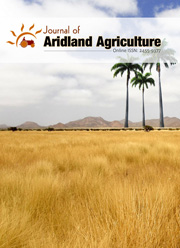Effect of Nitrogen, shading and intercropping on alfalfa-ziziphus agroforestry system under arid land conditions
DOI:
https://doi.org/10.19071/jaa.2016.v2.3000Abstract
To assess the arid lands agroforestry potential, a field experiment was performed at the Agricultural Research Station of King Abdulaziz University, located at Hada Al-Sham during the 2013 and 2014 seasons. Alfalfa was evaluated in a Ziziphus agroforestry system at a distance of 1 m, 2 m and 4 m from the ziziphus tree and were supplied with three different levels of nitrogen fertilizer 0 kg/ha, 200 kg/ha and 400 kg/ha in the form of commercial Urea. The fertilizer were subdivided into split doses and applied as manual broadcasting after each cutting. A split-split plot design was used with three replications. Forage growth rate and biomass accumulation were measured at ten different intervals approximately at a period of 30-40 days. Forage was harvested in 10 different cuts and all this data consisting of plant height, fresh biomass accumulation and dry biomass accumulation and leaf nitrogen content were also measured. Statistical analysis described significant impact for intercropping, planting distance and nitrogen fertilizer on all studied traits. The maximum effect of urea fertilizer was documented for the highest dose of 400 kg/ha but it was statistically non-significant to 200 kg/ha. Distance of planting from the Ziziphus tree produced variable trend for all forages at different cut numbers but 2 m produced maximum plant height and biomass accumulation for most of the cut numbers. The interaction of 200 kg N/ha, intercropping and 2 m distance produced optimum forage growth and biomass accumulation as compared to the sole plantation under no fertilization. Â
Downloads
References
Abusuwar, A. O., & Bakhashwain, A. A. (2012). Effect of different chemical fertilizers on seed yield and seed yield components of alfalfa grown under stress environment of western Saudi Arabia. International Journal of Science and Nature, 3(1), 114-116.
Darfaoui, E. M., and Assiri, A. A. (2010). Response to climate change in the Kingdom of Saudi Arabia. Director General of the Department of Natural Resources, MOA. KSA, 1-17.
El-Nakhlawy, F.S. (2010) Experimental Design and Analysis in Scientific Research. Sci. Pub. Center, King Abdul Aziz University, Saudi Arabia
FAO (2006). Highlands and Drylands, Mountains, a source of resilience in arid regions. p, 1-115.
FAO, 2011. Grassland Index. A searchable catalogue of grass and forage legumes. FAO.
Gold and Mson 2013. Defining agroforestry. In manual for applied agroforestry practices. Gold M, Cernusca M and Hall M (eds). The Centre for Agroforestry, University of Missouris, USA.
Jama B and Zeila A. 2005. Agroforestry in the drylands of eastern Africa: a call to action. ICRAF Working Paper – no. 1. Nairobi: World Agroforestry Centre.
Jose, S., Gillespie A.R., and Pallardy, S.G. (2004). Interspecific interactions in temperate agroforestry. Agroforestry Systems, 61: 237- 255.
Kinama, J. M., Stigter, C. J., Ong, C. K., Ng'ang'a, J. K., & Gichuki, F. N. (2007). Contour hedgerows and grass strips in erosion and runoff control on sloping land in semi-arid Kenya. Arid land research and management, 21(1), 1-19.
Lundgren, B., Introduction [Editorial]. Agroforestry Systems, 1982. 1: p. 3-6.
Ong, C. K., Wilson, J., Deans, J. D., Mulayta, J., Raussen, T., & Wajja-Musukwe, N. (2002). Tree–crop interactions: manipulation of water use and root function. Agricultural water management, 53(1), 171-186.
Osborne, P. L. (2000). Tropical ecosystems and ecological concepts. Cambridge University Press.
Radović, J., Sokolović, D., & Marković, J. (2009). Alfalfa-most important perennial forage legume in animal husbandry. Biotechnology in Animal Husbandry, 25(5-6-1), 465-475.
Tamang, B., M.G. Andreu, and D.L. Rockwood, Microclimate patterns on the leeside of single-row tree windbreaks during different weather conditions in Florida farms: implications for improved crop production. Agroforestry Systems, 2010.
Tamang, S., Paudel, K. P., & Shrestha, K. K. (2014). Feminization of agriculture and its implications for food security in rural Nepal. Journal of Forest and Livelihood, 12(1), 20-32.
Al-Zahrani, K. H., and Baig, M. B. (2011). Water in the Kingdom of Saudi Arabia: sustainable management options. The Journal of Animal & Plant Sciences, 21(3), 601-604.




 .
.